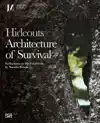- Engels
- Pockets
- kunst algemeen
- tentoonst. catalogus
- HIDEOUTS: ARCHITECTURE OF SURVIVAL
HOLLAND, AGNIESZKA
HIDEOUTS: ARCHITECTURE OF SURVIVAL
43,95incl BTW
Vertrouwd sinds 1927
Persoonlijke aandacht en advies
Vanaf 17,50 gratis verzenden NL & BE
Meer dan 150.000 artikelen online
Omschrijving HIDEOUTS: ARCHITECTURE OF SURVIVAL
Approximately 50,000 Jews survived the Holocaust in
occupied Poland and Ukraine, some of them using hideouts.
Driven by necessity, they were forced to seek refuge
in unlikely and seemingly unsuited places such as tree
hollows, closets, basements or sewers-staying there for
days, and sometimes even years. They are a testament to
the architectural creativity of those who had to secure the
basic means of sustaining life with minimal resources,
without being able to radically alter the space available
to them.
Architect, scholar and artist Natalia Romik has identified
and studied several hideouts that still exist today.
Her research, resulting in the exhibition Hideouts. The
Architecture of Survival, accentuates the material and spatial
dimensions of living in hiding, gathering the evidence
of vernacular, architectural creativity employed under
life-threatening conditions. This interdisciplinary catalogue,
addresses the fundamental question of the function
of architecture in relation to the history of violence
and our culture of commemoration.A graduate in political science, practitioner of architecture and artist, NATALIA ROMIK (*1983, Warsaw) received a PhD at London''s Bartlett School of Architecture in 2018. Romik has been awarded numerous grants, including the London Arts and Humanities Partnership, and the Scholarship of the Minister of Culture and National Heritage of Poland. Currently she is a postdoctoral fellow at the Foundation for the Memory of the Shoah in Paris.
occupied Poland and Ukraine, some of them using hideouts.
Driven by necessity, they were forced to seek refuge
in unlikely and seemingly unsuited places such as tree
hollows, closets, basements or sewers-staying there for
days, and sometimes even years. They are a testament to
the architectural creativity of those who had to secure the
basic means of sustaining life with minimal resources,
without being able to radically alter the space available
to them.
Architect, scholar and artist Natalia Romik has identified
and studied several hideouts that still exist today.
Her research, resulting in the exhibition Hideouts. The
Architecture of Survival, accentuates the material and spatial
dimensions of living in hiding, gathering the evidence
of vernacular, architectural creativity employed under
life-threatening conditions. This interdisciplinary catalogue,
addresses the fundamental question of the function
of architecture in relation to the history of violence
and our culture of commemoration.A graduate in political science, practitioner of architecture and artist, NATALIA ROMIK (*1983, Warsaw) received a PhD at London''s Bartlett School of Architecture in 2018. Romik has been awarded numerous grants, including the London Arts and Humanities Partnership, and the Scholarship of the Minister of Culture and National Heritage of Poland. Currently she is a postdoctoral fellow at the Foundation for the Memory of the Shoah in Paris.
Reviews
0.0/5.0
Gemiddelde uit 0 reviews
Meest behulpzame reviews
Nog geen reviews geschreven


